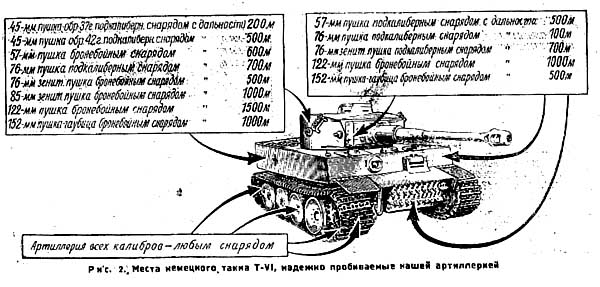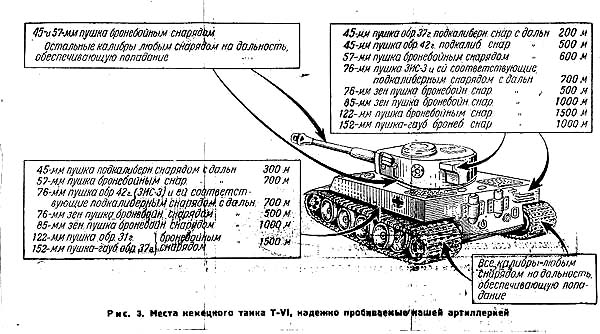| Back to the main index Back to the section index |
| Back to the main index Back to the section index |
In the recent battles Germans used their new heavy tank T-VI (see Pic.1) named Tiger (Elefant, Henschel).
These tanks cover action of medium tanks, at the same time, acting themselves under the cover of medium tanks. As a rule, they do not come forward. Very often tanks T-VI open fire from distances 1.5-2.5 km.
They retreat (reverse) from under the fire of our artillery.
Dimensions of T-VI.
Length - 6220 mm
Width - 3600 mm
Height - 2940 mm
Armament: one 88-mm anti-aircraft gun and two submachine guns 7.92-mm.
The front part of T-Vi is reliably penetrated by anti-armor shells of 45-mm guns model 1942 and 57-mm and 76-mm of all models from distances 100-700 m, by armor-piercing shells of 122-mm guns model 1931, 152-mm gun-howitzers model 1937 from 700-1000 m.
Sides, rear part and turret additionally to that are penetrated by subcaliber shells of 45-mm gun from 200-500 m, by armor-piercing shells of 57-mm AT guns, 76-mm and 85-mm antiaircraft guns from 1000 m.
Commanders of gun crews and gunners must carefully study and know vulnerable places of the tank, as well as which shell of which gun from what distance kills the tank.
Suspension, base of turret and gun are the most vulnerable places.
A hit of any shell from any gun in suspension stops the tank. The best is firing from angles 0-30░ as in this case a few wheels are damaged and track is broken.
A hit in the base of turret blocks it and prevents rotation of the turret in the desired direction, The tank has to turn and expose to the fire its most vulnerable places.
A hit in the gun forces the tank to disengage from the battle.


Damaged tank that retained its armament and some fighting ability must be rendered useless by fire at its gun and turret.
A gun must pick up target among attacking tanks with the consideration of best shooting angles 0-30░ , that is, the target must be to the side of the gun.
Guns of all types fire the standard shells only at suspension, turret's base and gun.
By subcaliber and armor-piercing shells the fire is effected from:
45-mm gun model 1937
suspension, turret's base and gun - by armor-piercing shells;
from 200 m at sides, rear and turret - by subcaliber shell;
45-mm gun model 1942
suspension, turret's base and gun - by armor-piercing shells;
from 500 m at sides and turret - by sun-caliber shell;
from 100 m at front part.
57-mm gun
from 600 m at sides, rear and turret - by armor-piercing shells;
from 500 m at front part by sub-caliber shells.
76-mm gun model 1942
at suspension, turret and gun;
from 700 m at sides, rear, turret - by sub-caliber shells;
from 100 m at front part.
76-mm AA gun
from 500 m at sides, rear and turret - by armor-piercing shells;
from 700 m at the front part by sub-caliber part.
85-mm AA gun
from 1000 m at sides, rear and turret.
122-mm model 1931
from 1000 m by armor-piercing shell at the front part. Rear, sides and turret can be hit from 1500 m.
152-mm gun-howitzer model 1937
from 1000 m by armor-piercing shell at sides, rear and turret. Front part can be hit from 500 m.
Commanders of gun crews and gunners must allow tank to close up, as close as possible, and open fire from distances securing reliable destruction.